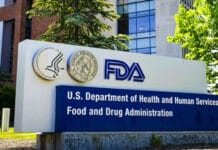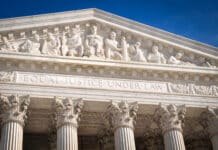(The Center Square) — An oversight committee hearing Wednesday highlighted the cost of fraud in taxpayer-funded pandemic relief programs as federal agencies continue to tally losses.
“We owe it to the American people to get to the bottom of the greatest theft of American taxpayer dollars in history,” said House Committee on Oversight and Accountability Chairman James Comer, R-Kentucky. “We must identify where this money went, how much ended up in the hands of fraudsters or ineligible participants and what should be done to make sure that it never happens again.”
Democrats pushed back. Committee ranking member Jamie Raskin, D-Maryland, said the pandemic relief programs, such as expanded Unemployment Insurance, kept millions of people out of poverty and saved lives.
“Expanded [Unemployment Insurance] benefits kept an estimated 5 to 6 million people out of poverty in 2020 and 6.7 million people above the poverty line in 2021,” Raskin said. “The Center for Budget and Policy Priorities estimates expanded benefits may have saved the lives of as many as 27,000 people in high-risk occupations who may have died from COVID had they not had access to benefits.”
He blamed former President Donald Trump’s administration for failing to address fraud and waste in the federal relief programs.
“Organized criminals and fraudsters took advantage of these circumstances by exploiting weaknesses in our IT systems,” Raskin said. “This problem was compounded by critical decisions made by the Trump administration that hamstrung pandemic relief anti-corruption oversight from the very outset, crippling the government’s ability to detect fraud.”
Comptroller General of the United States Gene Dodaro testified that agencies should have been better prepared to deal with fraud. He said lawmakers passed the Fraud Reduction and Data Analytics Act in 2016, which required agencies to implement fraud prevention methods from the U.S. Government Accountability Office. But that didn’t happen.
“Agencies were slow to implement this legislation and therefore were not prepared properly when the coronavirus emergency occurred,” he said.
Dodaro said the urgency to get pandemic aid to people and businesses quickly led to trade-offs at the expense of accountability and transparency, such as allowing self-certification of applications and limiting the amount of supporting documentation required for applications. Lawmakers have since made changes to fix some of those issues to reduce fraud.
In general, the federal government needs to do a better job of making the correct payments to the correct people, Dodaro said.
“The government has an underlying improper payment problem. These are payments that shouldn’t have been made or were made in the wrong amounts,” he said. “I’ve testified before this committee many, many times on this problem over the years. It occurs in a wide range of federal programs. It’s pervasive across the government. When you have that type of problem on a regular basis and you add additional spending of hundreds of billions — trillions in this case — you are going to have these types of problems.”
Lawmakers passed six COVID-19 relief laws that provided about $4.6 trillion for pandemic response and recovery. Of that, about $4.1 trillion had been spent as of Nov. 30, 2022, according to the U.S. Department of the Treasury.
A federal report released last week estimated more than $60 billion in unemployment insurance fraud during the pandemic. The U.S. Government Accountability Office report noted that the figure was an estimate spread over the entire unemployment system and should be “interpreted with caution.” So far, state workforce agencies have proven $4.3 billion of unemployment fraud and at least $45 billion more in transactions that were flagged as potential fraudulent unemployment claims but not confirmed. The U.S. Department of Labor reported that about $878 billion in total unemployment benefits were paid from April 2020 through September 2022.
Both the Paycheck Protection Program and COVID-19 Economic Injury Disaster Loan program were hit by fraud, but estimating those losses have proven difficult so far.
“The extent of fraud associated with these and other COVID-19 relief programs has not yet been determined,” Dodaro said in a 51-page report he provided to the committee. “One of the many challenges in determining the full extent of fraud is its deceptive nature.”
David Smith, assistant director for the Office of Investigations for the Secret Service, told the committee that the pandemic created new opportunities for criminals.
“The volume of fraudulent activity related to CARES Act funding was and is substantial, yet a similar dynamic has been seen before with other major relief efforts or natural disasters,” Smith said in written testimony. “The COVID-19 public health crisis presented an opportunity for both organized criminal groups and individuals intent on taking advantage of these important resources.”
In less than three years, the Secret Service has opened thousands of investigations, recovered more than $1 billion and arrested more than 500 people, Smith said. He said there was more work to be done. Smith outlined several cases. In June 2020, a criminal ring based in South Florida got $24 million in pandemic relief funds using fake identities and shell companies set up years earlier to commit bank and credit card fraud. So far, $11 million of that has been recovered. Smith said additional seizures are expected.
Another criminal group used stolen identities, including at least 1,600 that came from an insider with access to hospital databases, to steal more than $80 million.
In July 2020, a group that included inmates at state and county penal institutions in Pennsylvania illegally got unemployment benefits. Ten people were arrested and more than $136,000 was paid in restitution, Smith said.
Pandemic Response Accountability Committee Chairman Michael Horowitz testified that the PRAC used a verification process to determine that 69,000 questionable social security numbers were used to obtain $5.4 billion in pandemic loans and that another 175,000 questionable social security numbers were used in applications that were not paid.
Horowitz said federal agencies failed to use some of the tools at their disposal to prevent fraud, including the Do Not Pay list. The U.S. Department of the Treasury had set up the list of suspicious payees who should trigger additional screening.
“This list was sitting there, this is not anything that would have taken much time” amid the rush to get payments out, Horowitz said.
Horowitz cited the Small Business Administration’s Paycheck Protection Program as an example.
“Almost $400 billion went out in two weeks in that program,” he said. “Of that amount, 57,000 — $3.6 billion — shouldn’t have gone out right away.”
Horowitz said advance screening with the U.S. Department of the Treasury Do Not Pay list could have saved taxpayer money.

















